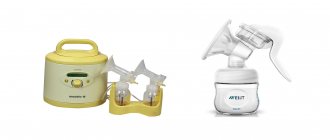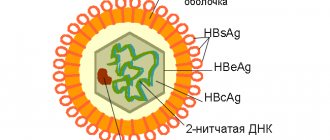Almost immediately after the formation of the country of Israel, its citizens had to take up arms to defend their independence. In 1948, the Arab-Israeli war began, the first of many that would take place during the 2nd half of the 20th century. The Israelis showed themselves to be quite good and brave fighters, but there was one problem: an acute shortage of weapons, including small arms. And what was available could hardly be called high-quality and modern.
Israeli fighters fought with a variety of weapons left over from World War II: these were German MP40 submachine guns and English STENs and Russian PPSh assault rifles. This weapon was not very well suited to the Middle Eastern theater of operations. Huge amounts of sand and dust often led to failures and breakdowns.
Among those who experienced all these difficulties and hardships was the young lieutenant Uziel Gal, the future designer of the Uzi submachine gun.
Thanks to its amazing qualities, this submachine gun has entered the golden collection of small arms. By the way, the designer himself did not want the weapon to be named after him, but this worldview was ignored.
The Uzi is so comfortable, reliable and easy to use that it almost immediately became a favorite of special services and police officers.
History of creation
His friends called him Uzi, but Major Uziel Gal never wanted that name attached to the weapon he developed. But the Israelis simply ignored his request, and the Uzi submachine gun, one of the most iconic firearms in history, was born.
For Uzi, the creation story begins on May 14, 1948, when the state of Israel emerged, which was immediately attacked by the neighbors of the new country. Although the young Israelis fought off the attacks, it was clear that the new nation-state needed new firearms to replace the outdated weapons of World War II.
Uziel Gal was based on the Czech CZ25 submachine gun, developed in the late 1940s, which used an open bolt and a magazine inserted into the pistol grip. These main features formed the basis of the Uzi design.
Uzis were produced in several modifications, including two shortened versions (mini and micro versions). The most recent version of the Uzi Pro is still used by some special forces units.
Many people mistakenly use the name “Uzi machine”. In fact, this is not the case, because this weapon exclusively uses the 9 mm pistol cartridge. Therefore, the Uzi is a submachine gun, not an assault rifle.
Gunsmith of the Jewish Underground
Gotthard settled in his father's house, in a kibbutz, and soon returned to his favorite pastime - together with a friend he began to collect a collection of weapons, now separate from his father's, getting them wherever possible. So, having learned that their school teacher had a Beretta pistol, the teenagers exchanged it for Zeiss army binoculars, which in those years were much more expensive than a pistol. At the same time, he joined the ranks of the semi-underground organization "Haganah" ("Defense"), and then into its shock troops "Palmach", which in the very near future were to become the basis of the IDF - the Israel Defense Forces. Then he changes his name - from Gotthard he turns into Uziel, Uzi. He would become Galem from Glass later - in the early 1950s.
Automatic Uzi
The Palmach command immediately drew attention to the teenager, who was unusually well versed in all types of weapons, and appointed him responsible for the secret arsenals of the Jewish underground scattered throughout Palestine. But Uzi Gal not only monitors the serviceability of the organization’s weapons - he is literally obsessed with creating new types of weapons. To begin with, in 1938, he created an automatic crossbow capable of firing arrows in bursts, and after this he began to think about the idea of a new automatic rifle. From time to time he sneaks into the kibbutz's locksmith's workshop and grinds out certain parts of his future brainchild. One day, one of the adults caught him doing this and tore Uzi by the ears. Which, however, did not at all cool the ardor of the young inventor.
In 1943, Uzi Gal was already twenty years old, and the idea of creating a new machine gun for Palmach fighters was becoming almost obsessive to him. This was all the more important because the main and almost only weapon of the fighters of the Jewish self-defense units was then the English Stan rifle - extremely inconvenient to use, with an effective firing range of only 100 meters, with a low rate of fire, and which, in addition, constantly jammed. Uziel Gal again and again built on paper, and then turned in the workshop various parts of the future machine gun, created prototypes and himself tested them in the shooting range, but the results of his work clearly left much to be desired. One day he was detained by an English patrol, and during a search, parts of one of the unsuccessful samples were found in his bag. The British did not fully understand what exactly was in their hands, but there was no doubt that we were talking about weapon components, and Uzi Glass was sentenced to seven years in prison. He served his sentence in the famous military prison in Acre, a former crusader castle, and used this time to obtain a degree in mechanical engineering by correspondence. Uzi did not serve until the end of his assigned term - the State of Israel was created in May 1948, a few days later the Arab world declared war on him, and upon his release, Glass immediately found himself at the front, taking part in fierce battles for the Galilee.
Device
Gal based his weapon in part on designs for earlier Czech submachine guns, in which cartridges were fed into the chamber from a box magazine inserted into the pistol grip. The Uzi has a blowback action that travels along most of the barrel when fired. Gal combined these characteristics to create a weapon that was compact, had a lightweight loading mechanism, was reasonably stable and accurate even with automatic fire, and had good reliability.
The Uzi has a rectangular receiver with front and rear "half-round" sights on the ends of the receiver. The magazine is inserted into the pistol grip, with a round cocking handle on the receiver.
The barrel can have several different configurations. Its design ensures a very short overall length and makes the weapon insensitive to contamination. Operating on the principle of a bolt action and recoil spring, the Uzi can fire in full-automatic mode, but is also available in semi-automatic mode. It has a folding stock and can be equipped with a silencer.
The Uzi submachine gun is based on the open bolt principle. The bolt is located behind the pistol grip with the magazine. The shot occurs when the shutter is in the forward position. This arrangement offers several advantages. Firstly, the dimensions of the weapon are reduced, since most of the barrel is in the body, and secondly, the recoil is reduced, because at the moment of firing, the bolt moves forward.
We recommend reading → Walther PPK: history of the creation of the pistol, design, characteristics (technical characteristics)
The trigger has two fire modes: single and automatic. The fire switch is also a fuse. There is another automatic safety, which is located in the pistol grip; the safety on the famous Colt 1911 works on the same principle. If the hand does not clasp the grip and press the safety button, the shot will not fire.
The submachine gun has a folding metal stock.
Principle of operation
- When you press the trigger, the bolt first feeds the cartridge into the chamber
- Immediately after this there is a shot
- Under the influence of powder gases, the bolt returns to the rear position
- The cycle repeats
Taken name
In 1981, Gal proposed the next new product - the “mini-ultrasound”, which was a regular model reduced by 27%. Any bodyguard could easily hide this machine gun under his jacket, which is what they began to do. It was the “mini-Uzi” that was used by Ronald Reagan’s bodyguards at the moment when the assassination attempt was made. By this time, Uziel Gal felt that he was tired and it was time to retire. After retiring, in 1986, together with retired Lieutenant Colonel Yitzhak Jacobi, he developed a new pistol, which he called the Uzi-201. But then it turned out that the Uzi brand is considered the property of the state. The Defense Industry Concern filed a lawsuit against Uzi Gal demanding that he be prohibited from developing new types of small arms and using the word “Uzi” in its name.
The court, of course, rejected the demand to prohibit the great gunsmith from doing what he loved, but he actually forbade him to use the Uzi brand. Thus, in the end, even Gal’s name was taken away. In September 2002, Uzi Gal died. A year later, the Uzi assault rifle was actually removed from service in the Israeli army - after several cases of injury to recruits due to involuntary shots fired from it. But the Uzi story did not end there. If in 1987 the “micro-Uzi” appeared on the arms market, then in 2010 its improved model “Uzi-Pro” is an ideal weapon for bodyguards, security guards and... those same gangsters. So it’s too early to say goodbye to the Uzi. Rather, on the contrary: humanity will encounter it more than once. Under different circumstances. In various hot spots of the planet. On the hands of both “good” and “bad” guys. Because the automaton is not asked who it wants to serve and who it does not.
Characteristics in comparison with analogues

The very first analogue that comes to mind for comparison with the Israeli Uzi assault rifle is the American Mac 10. They use the same ammunition (9x19), are similar in appearance, and are designed to perform the same tasks. These are two compact PDWs that are intended to be discreet self-defense weapons.
The MAC 10 and Uzi are submachine guns that have been in service with armies for a long time, and they both use pistol cartridges. The Uzi has a longer history, having been developed in the 1940s, while the MAC 10 or Model 10 was created in 1964.
Among experts, Uzi enjoys great prestige, primarily due to the fact that the design is more reliable and less susceptible to overheating.
Mac 10 weighs almost a kilogram less than Uzi (2.8 kg for MAC 10, versus 3.5 kg for UZI)
It also wins in length (548 mm for MAC 10 and 640 mm for UZI). The MAC 10 also benefits in barrel length, so the MAC 10 can confidently be called a more compact weapon.
Another difference is the rate of fire. The Uzi has a rate of fire of 600 rounds per minute, while the Model 10 has a rate of fire of 1090.
However, despite the above advantages of the Model 10, the Uzi is still considered the best PP. The first reason is the rate of fire. Due to the smaller dimensions, barrel length, but higher rate of fire, it is more difficult to control the weapon and shoot accurately. Model 10 is more susceptible to overheating and will lose to the UZI in reliability.
Conclusion: The MAC 10 is more compact and faster-firing than the Uzi. But due to the design features, the Uzi submachine gun has better accuracy, effective firing range and reliability.
Performance characteristics (TTX) of Uzi
The barrel length is only 260 mm (10 inches). The submachine gun weighs about 4 kg with a magazine. Magazines come with 25 or 32 rounds of 9 mm caliber. The Uzi also comes in miniature versions, measuring just 460mm in length.
| Ammunition used | 9x19mm Parabellum |
| Length | 640 mm |
| Barrel length | 260 mm |
| Weight | 3.5 kg |
| Magazine capacity | 25, 32 rounds |
| Rate of fire | 600 shots /min |
| Sighting range | 200-250 m |
Recommended reading → Glock 18: the main difference from the seventeenth model
What will the first ultrasound examination show?
The first ultrasound during pregnancy is performed at 10–13 weeks, provided that it is registered in a timely manner and there are no indications for earlier dates. It is best to undergo the first screening approximately in the middle of this period.
The ultrasound screening system in obstetric practice is used for mass examination of pregnant women for the purpose of early identification of risk groups. Specifically for the first screening, the earlier developmental disorders of the fetus or provisional organs are detected, the more difficult the defect can be expected. However, in the early stages it is easier to make adjustments to the course of pregnancy.
During the planned first ultrasound, the size of the unborn child is calculated (fetometry). Fetometry includes the coccygeal-parietal distance, interparietal size, head girth, abdominal girth and chest diameter, limb length, which is often assessed by the length of the femur. However, to clarify, you can also measure the humerus, radius, ulna, tibia, fibula and foot bones.
A separate important point is the need to measure the size of the nasal bone and the width of the collar zone, deviations of which from the norm serve as markers of chromosomal diseases (markers reveal an increased risk of pathology, but cannot accurately indicate a developmental disorder).
In addition to fetometry, indicators such as the height and weight of the unborn child, heart rate, and placental thickness are assessed.
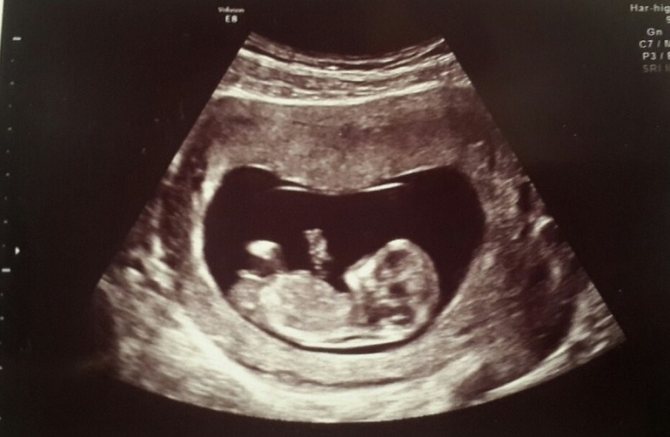
At this stage of fetal development, this study allows us to identify the presence or absence of serious defects
Indicators of the first ultrasound and their interpretation
Interpretation of fetal ultrasound includes several parameters. Fetal weight at the time of first screening is on average: 5–12 cm, weight 8–30 grams.
| a week | body length, cm | body weight, gr. |
| 10 | 5,2 | 8 |
| 11 | 6,8 | 11 |
| 12 | 8,2 | 19 |
| 13 | 10,0 | 31 |
Fetometry indicators: ● 10 week: size from the crown to the coccyx: 33–49 mm, size between the parietal tubercles 14 mm. ● Week 11: size from the crown to the coccyx: 42–58 mm, size between the parietal tuberosities 17 mm. ● Week 12: size from the crown to the coccyx: 51–60 mm, size between the parietal tubercles more than 20 mm. ● Week 13: size from the crown to the coccyx: 61–73 mm, size between the parietal tuberosities 23–30 mm. Fronto-occipital distance 29–35 mm, head circumference 92–99 mm, abdominal circumference 64–70 mm. Femur length 11 mm, tibia 9 mm, fibula 8 mm, humerus length 10 mm, radius length 6 mm, ulna 8 mm, foot length 12 mm.
| a week | heart rate per minute |
| 10 | 160 — 180 |
| 11 | 155 — 175 |
| 12 | 150 — 175 |
| 13 | 145 — 170 |
The size of the nasal bone at 10–11 weeks is difficult to assess by ultrasound, but it is already beginning to be defined as a local tissue compaction. At week 12 it is 2.0–4.2 mm, at week 13 it is the same. Nuchal collar zone: at 10 weeks 1.5–2.1 mm, at 11 weeks 1.6–2.3 mm, at 12 weeks 1.6–2.4 mm, at 13 weeks 1.7–2.6 mm . Placental thickness: at 10 weeks 13.44 mm, at 11 weeks 14.29 mm, at 12 weeks 15.14 mm, at 13 weeks 16.0 mm.
Advantages and disadvantages of UZI
pros
Simplicity of design. The weapon is easy to disassemble and clean. This significantly increases its durability.
The parts are easy to manufacture. Thanks to the abundance of stamped parts, the weapon is inexpensive to produce
High reliability. Simplicity and large design tolerances keep delays and non-feeds to a minimum.
Relatively small dimensions. The weapon can be carried secretly under a raincoat or jacket. A special shoulder holster was created for this purpose.
Good weight distribution of weapons.
Minuses
Its main drawback is that it only fires pistol ammunition. This leads to reduced, in comparison with assault rifles, accuracy, firing range, bullet speed, striking and penetrating ability. The Uzi is a melee weapon.
Combat use
At first, the weapon was popular only in the Israeli Armed Forces. It was put into service in 1956 and was used as a PDW (Personal Defense Weapon or weapon for self-defense), primarily by artillerymen and tank crews, for whom an assault rifle was too large and heavy. The weapon was used by the Israeli army during the Suez Crisis (1956), the Six Day War (1967) and the Yom Kippur War (1973).
Perhaps Uzi's most famous appearance outside of Israel occurred in March 1981, when a mentally unstable man named John Hinckley Jr. attempted to assassinate President Ronald Reagan with a .22-caliber revolver. The President was seriously wounded by the ricochet. A famous photograph from that day shows Secret Service Special Agent Robert Vanko, Uzi in hand, surveying the crowd as the President and other wounded were evacuated. The Uzi remained the Secret Service's PDW of choice well into the 1990s.
At the moment, the Uzi is not in service with the army in Israel, as it is outdated. The Uzi replaced the Tavor and M4A1 carbines.
What is PMP (PVP) on ultrasound during pregnancy
The abbreviation PMF is the estimated fetal weight (PVP is the estimated fetal weight).
To determine the weight of the fetus using ultrasound data (which is more accurate than other methods), the following data is required: fetal age in weeks, head dimensions (interparietal distance, fronto-occipital distance or head circumference), abdominal circumference, chest diameter and thigh length.
The longer the pregnancy, the greater the individual characteristics that the fetus can manifest, therefore, if the PMP does not coincide with the tabulated data of norms for a given period, this is not a reason to panic. The weight of a child, as a rule, at birth can vary within very large limits.
Modifications
Uzi has several modifications.
- Mini Uzi
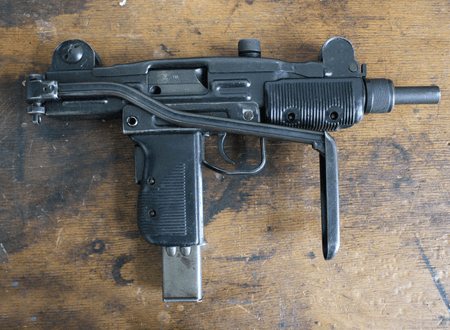
The Mini Uzi has a folding stock. Due to the weapon's downsizing, the receiver is smaller, the bolt is smaller, and the barrel is shortened to approximately 7.75 inches (196 mm). The rate of fire is 950 rounds per minute. Production began in 1980.
- Micro Uzi
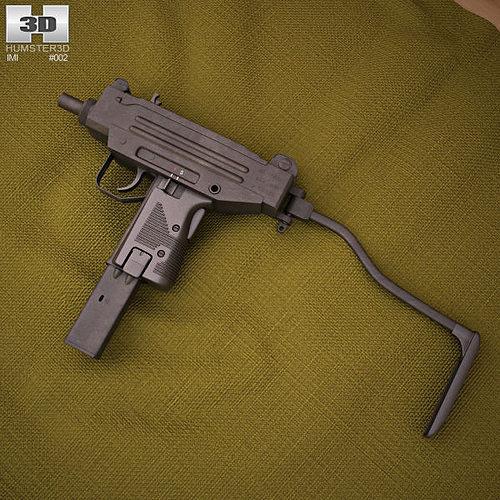
The Micro Uzi is scaled down even more than the Mini Uzi; It has a 4.7-inch barrel and fires at 1,200 rounds per minute. A stock can also be used on this weapon. Production began in 1983.
- Uzi Pro

In this variant of the Micro Uzi, the cocking handle has been moved to the left side of the receiver. The grip and fore-end are made of polymer, and the grip design has been modified to allow two-handed grip, which would improve shooting technique and allow for more precise control of the weapon. The Uzi Pro has two rails on the barrel and one on top for mounting scopes and other tactical equipment. Production began in 2010.
- Norinco Model 320
We recommend reading → PP-91 Kedr submachine gun: developed by Dragunov
An unlicensed copy of an Uzi made in the mid-1990s in China by Norinco, with a wooden stock.
Chilled Uzi
Quite a rare and very expensive example. Remade in Russia from the original Israeli Uzi. Uses a 10x31 blank cartridge. All functions and controls are retained. The only change is the deactivation of the weapon's warheads to eliminate the possibility of firing live ammunition.
Traumatic Ultrasound
At the moment, there is no sample that completely copies the combat prototype. However, in 2009, a traumatic pistol was created in Turkey, created in the image and likeness of the Uzi, which is called the Zoraki 925. It is extremely vaguely reminiscent of the Uzi, because it has the same magazine mounting system in the handle, and it also has similar features in appearance.
The submachine gun is manufactured by Zoraki in Turkey, uses a 9 mm PAK cartridge, has an automatic firing mode and a magazine capacity of 16 to 25 pieces.
This submachine gun was copied and remade by a Russian company with some changes (10-round magazine and no automatic fire mode), because otherwise the pistol would not have passed the requirements of Russian legislation.

Pneumatic versions
Produced by several companies. The largest of them: Umarex, Gletcher. In general, they differ little from each other. They use CO2 canisters and shoot 4.5 mm balls. They have an external replica of the original, but differ significantly in weight. All controls (including the automatic safety in the handle) are retained. Sold without a license.
Recommendations for using Uzi air pistols
Perhaps the main recommendation when using the Uzi submachine gun is constant care of the barrel and main mechanisms. This includes cleaning and lubricating the inside of the barrel.
- Constant care of the insides of the pneumatic is required. Including cleaning and lubricating the inner barrel.
- Don't skimp on balloons and gas cylinders. Low-quality components will lead to increased wear of the “weapon” and rapid failure.
Mass-dimensional model (MMG)
This is an original Israeli machine gun, to which design changes have been made to deactivate the weapon. MMG has only collection value. Deactivation: the barrel is drilled, the chamber is welded, a welded steel pin is inserted into the chamber through the receiver (which eliminates the need to replace the barrel), the bolt mirror is cut off.
Accessories for Ultrasound

The early version of the Uzi has two accessories. This is a muffler designed to reduce the sound of a shot and a wooden stock (standardly installed on the German version of the Uzi, known as MP2).
The later modification of the Uzi-Pro has rails for attaching attachments, which dramatically expands the range of accessories. These can be sights, flashlights, tactical grips, laser target units.

